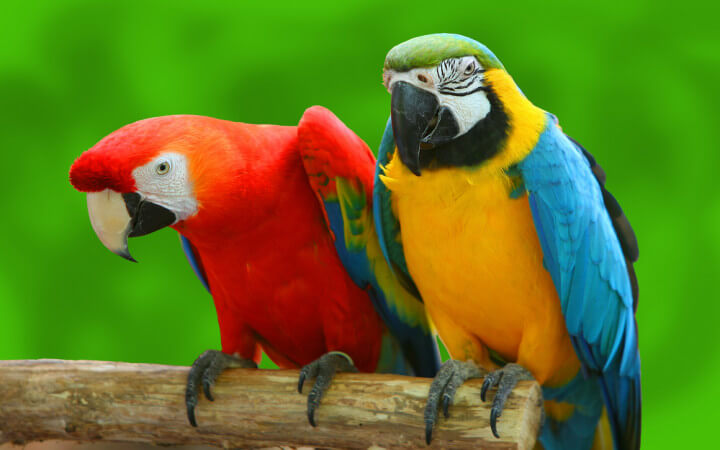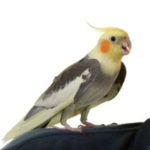Exotic birds like parrots fascinate us. They are interesting animals, and many people enjoy having them as pets.
Both their diet and their emotional states are completely unique to these stunning creatures.
Parrots come in a wide range of sizes and colors, and there are many different species.
They are extremely clever and amusing animals that can accurately imitate human speech (at least some can).
Around 400 kinds of parrots can be found in the wild today.
Because of the joy and color, they may add to a house, some of them are frequently bred and raised by humans.
Like having a little child, taking care of a parrot at home increases your workload, but it also has a calming effect on the household and its occupants.
There are several factors to think about if you’re considering getting a parrot as a pet for your home.
To begin, 400 species is a sizable selection. Don’t worry though; we’ll be cutting it down to a much shorter list of the parrots that are typically purchased as companion birds.
The ten most common species of talking birds will be our primary emphasis, and we’ll provide you all the details you need about them, including average costs like initial outlay and ongoing maintenance and care.
Also, we’ll discuss the factors that make some parrots more expensive than others to purchase.
We hope that by the time you reach the conclusion of this piece, you will be well-informed enough to purchase a parrot as a pet without incurring any unanticipated expenses.
In addition, you’ll have a thorough understanding of the requirements for your bird’s care before setting foot in a pet store.
How Much Does a Parrot Cost? The 15 most popular parrot prices
First, we’ll discuss the top 10 most popular talking parrots as pets. These are the most popular choices for anyone looking to bring home a parrot as a pet.
In addition to giving you an overall cost estimate, we’ll also offer some explanations for why some kinds of parrots cost more than others.
This refers to the factors that determine the relative cost of various animal species.
Please keep in mind that the average costs listed below are accurate just as of the date this article was written. Parrot prices may rise or fall in the future.
When looking to purchase a bird, you may see that prices have changed.
1. Parakeet
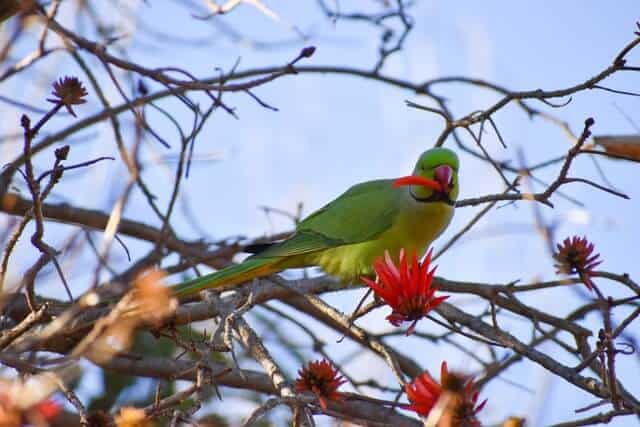
The long feathers on a parakeet’s tail are the most distinctive feature of this little to medium-sized bird.
They share a similar slim physique and are both seed eaters. Almost 115 different types of parakeets share the aforementioned characteristics.
You might also come across paroquet or paraquet, which are just two of the many obsolete spelling variations of the same term.
To put it simply, parakeets have always lived in Australia.
However, in American English, the word “Parakeet” only refers to Budgerigar. Common names for these birds include Budgies and Parakeets.
Similar to other parakeets, budgies are easily recognizable due to their long, slender tail feathers.
In addition, their feathers are green with black scalloped lines, and their necks are a bright yellow. These parrots feed primarily on seeds.
The Scarlet-Chested Parakeet, Yellow-Chevroned Parakeet, Red Bump, Plum-Headed, Ringneck, Monk Parakeet, White-winged, Lineolated, Bourke’s Parakeet, Alexandra’s Parakeet, Mustached Parakeet, etc. are all examples of other species of parakeets.
Parakeets are commonly referred to as Budgerigars in the United States.
A single parakeet can be purchased for as little as ten dollars and a pair for as much as eighty dollars.
Parakeet prices vary widely depending on the breeder and the conditions in which the birds were kept before the sale.
In other words, parakeets sold by breeders tend to be more expensive than those purchased from pet stores, who provide superior care and retain detailed records.
Because it is easier to train and is more conversational-ready, a parakeet that is used to interacting with humans will cost more.
2. Cockatoo
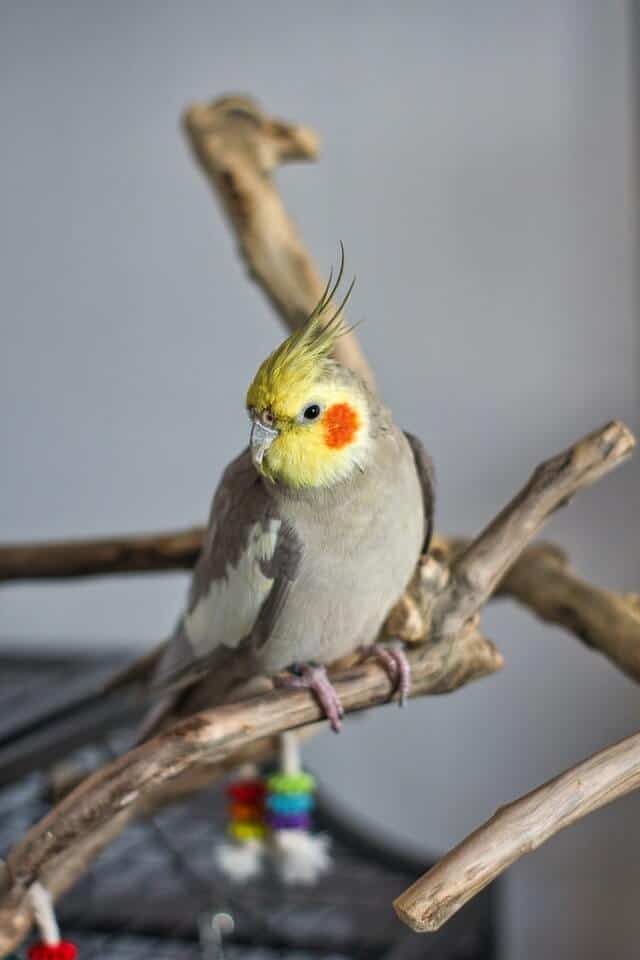
There are 21 species of cockatoos, all of which may be identified by their curved beaks and distinctive crests on their heads.
They tend to be bigger than other types of parrots. They were born in the areas between Australia, Indonesia, New Guinea, and the Solomon Islands.
Seeds, corn, flowers, insects, fresh fruit, and flowers are some of their favorite foods.
Cockatoos typically lack the vivid plumage of other types of parrots. They have a basic body color (often black, white, or grey) and colorful chest feathers.
Keeping a cockatoo as a pet might be challenging due to the bird’s particular requirements.
Cockatiels, the smallest member of the family, are more widely kept as pets than other members of the family because of their ease of maintenance.
Other members of the Cockatoo family include the Galah, the Bare-Eyed, the Gang-Gang, the Goffin’s Cockatoo, the Moluccan Cockatoo, the Citron-Crested, the Triton Cockatoo, the Red-Tailed Black Cockatoo, and many others.
The cost of a Cockatoo can vary from $500 to $1200, depending on the source. A bird’s price can also be affected by its size and color.
It’s important to note that more exotic birds, like the Umbrella Cockatoo, can easily set you back $3,000 or more.
Therefore, the value of a bird is based in part on how uncommon it is.
3. Macaw Parrot
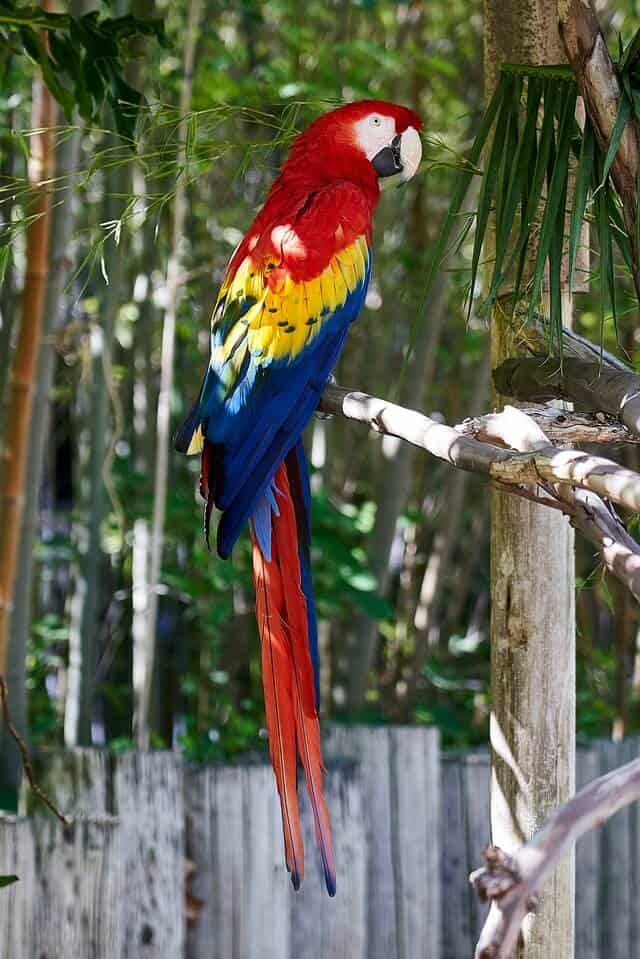
There are 19 different kinds of macaws (including extinct or endangered ones).
Among the bigger species of parrots, these birds are easily identified by their vivid plumage, disproportionately huge beaks, and extremely long tail feathers.
However, there are lesser species of macaws, such as the red-shouldered macaw, which is the smallest member of the macaw family.
There are many different kinds of macaws, such as the Hyacinth Macaw, the Scarlet Macaw, the Spix Macaw, the Cuban Red Macaw, the Catalina Macaw, the Hahns Macaw, the Hybrid Macaw, the Severe Macaw, the Harlequin Macaw, the Blue-Throated Macaw, the Green Wing Macaw, the Gold Macaw, etc.
Despite their massive size, these birds are known for their warmth and jovial nature. The vast majority of them were born in Central and South America.
Macaws can live for as little as 35 years (in the case of the lesser species) or as long as 75 years (in the case of the larger species).
Keeping macaws as pets or in zoos raises conservation and animal welfare concerns because the species is in danger of extinction.
Macaws consume anything from fruits and vegetables to seeds and nuts to palm fruits and even flowers and branches.
Macaws, like other giant parrots, tend to be more expensive than smaller kinds.
The cost of a Macaw, a popular choice for avian companions, can range from $1,000 to $18,000, depending on the bird’s size, color, and, most significantly, a rarity.
The price of a rare, huge bird is likely to be significantly higher than that of a common, smaller species.
4. African Greys
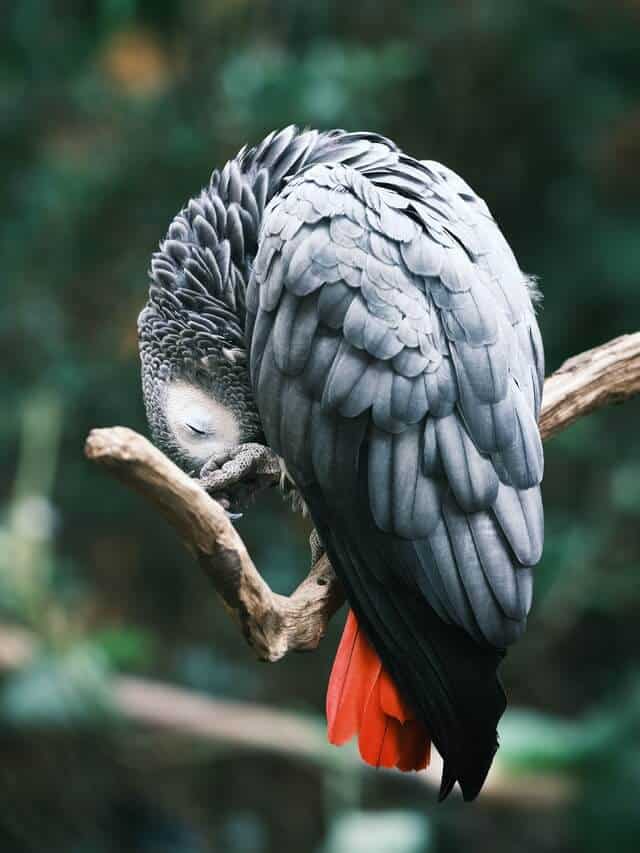
This species of parrot is notable for having a name that conveys a great deal about its characteristics.
Parrots with the appearance of an African Grey are native to the region of Equatorial Africa (Angola, Cameroon, the Congo, Gabon, Ivory Coast, Kenya, Ghana, and Uganda).
They’re mostly grey with a black beak, too. Both their crimson tail feathers and white eye rings make them easy to spot.
African Greys are divided into the Congo African Grey and the Timneh African Grey.
Physically, they look identical: both weigh around 0.9 pounds and have a dark brown coat color. Mentally, the Timneh is typically less anxious and more amenable to training.
Both birds are widely regarded as among the smartest in the animal kingdom.
As opposed to their short lifespan in the wild, African Greys kept as pets can survive for 40-60 years (around 23 years).
They are kept as pets because of their remarkable capacity to mimic human speech or any other sounds they encounter.
The going rate for an African Grey parrot is between $2,000 and $6,000. Because of their greater market presence, Congo African Greys are typically sold at lower prices than Timneh Greys.
Although their purchase price is cheaper than that of Timneh African Greys, ongoing expenses (such as insurance, veterinary care, a suitable cage, and feeding) are more.
5. Pionus Parrot
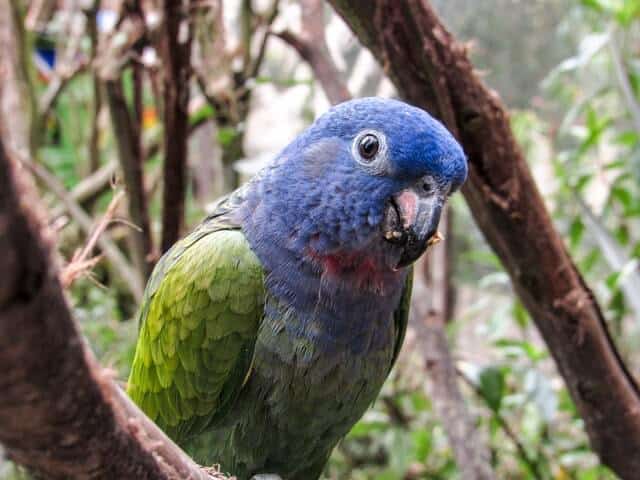
These parrots, of the genus Pionus, were first discovered in Mexico and Central and South America.
They are medium-sized parrots distinguished by a short, square tail, naked eye rings (sometimes in contrasting colors), and a stocky build.
The genus Pionus gets its name from the Old Greek word “pin / pionos,” which literally translates to “fat.”
Eight species of Pionus parrots exist, distinguished primarily by the coloration of their various body parts.
The Red-billed Pionus, Blue-headed, White-Crowned, Speckled-faced, Scaly-headed (Maximillian), Bronze-winged, White-Capped, and Dusky Pionus parrots are all in this group.
Only three of the many species of these animals are typically kept as pets in human households.
The blue-headed parrot, white-capped parrot, and Maximillian’s pionus are these (Scaly-headed). Fruits make up the bulk of the diet for wild Pionus parrots.
When keeping a bird as a pet, it’s important to avoid feeding it any fatty foods. If you need help figuring out what to feed your animal, a vet is your best bet.
Depending on the type of subspecies and how uncommon the bird is, you can expect to pay anywhere from $900 to $1700. But normally you should expect to pay around $1200.
6. Quaker Parrot
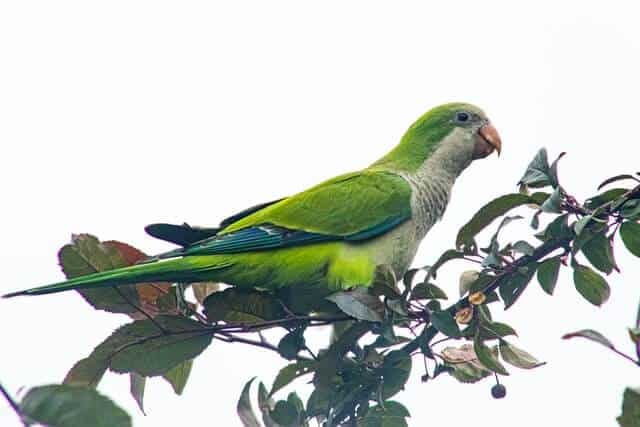
We’ve already established that Quaker Parrots, also known as Monk Parakeets, are a member of the parrot family.
These species are all about average in size, have lean bodies, and have long tail feathers in common.
The breasts and abdomens of Quaker parrots are grey, while their feathers are a vibrant green.
These parakeets hail from Argentina and the neighboring parts of South America, where they are smaller than the average parrot. A Quaker parrot can live for up to 30 years.
Parrots of the Quaker species are known for their high intelligence, sociability, and self-assurance.
Many bird keepers choose them due to their remarkable capacity for learning to talk, expanding their vocabularies, and even constructing words.
Quaker parrots have begun to overtake Cockatiels as the most popular pet bird to train to talk due to their rapid speech ability.
The going rate for a Quaker parrot is between $250 and $550.
The price of a bird is determined by several factors, including the breeder’s reputation and the method used to nurture the bird.
Adopters compete for these birds due to their high level of companionability and mental acuity.
7. Conure
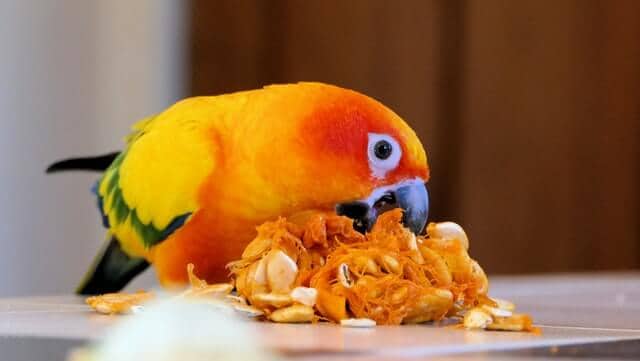
The jargon surrounding the many types of parrots can be difficult to decipher. Some individuals have trouble telling Parakeets and Conures apart.
Just to sum things up, while parakeets are native to Australia, the term “Conure” is used to refer to any large parakeets or small parrots that are found throughout the western hemisphere.
As of right now, you can only find a live Conure in either South or Central America.
The only bird that used to inhabit the Midwest, Eastern, and plains states of the United States is the Carolina Parakeet (Sadly, this species is extinct now).
Conures resemble Australian parakeets in body type and lifestyle (even if they are slightly larger).
Along with their long tail feathers and short yet powerful beaks, these birds also have (usually grey or black).
Parrots of the genus Conure are often referred to as “parrot clowns” because of their attention-seeking antics.
The norm for them was to swing back and forth, dance, or even hang upside down.
The Conure species are notoriously difficult to exactly categorise.
However, there are numerous subspecies, such as the Sun Conure, Green Cheek Conure, Nanday Conure, St. Thomas Conure, Cinnamon Green-Cheek Conure, Golden Conure, Crimson-Bellied Conure, Dusky Conure, Cherry-Headed Conure, Blue-Crowned Conure, Black-Capped Conure, Jenday Conure, Half-Moon Conure, Peach-Fronted Conure, etc.
As you may have guessed, many avian monikers are based on some distinguishing physical trait, such as a feather pattern or plumage color.
Fruits, veggies, grains, seeds, meat (chicken, salmon), and even tiny amounts of dairy are all fine for conures to consume.
The price of a Conure varies greatly from one species to the next due to the species’ relative availability and rarity.
Putting a price on Conures is difficult due to the variety of species available.
However, the price for one might be anything from $200 to over $3,000. Unsurprisingly, the more scarce a species is, the more it costs.
8. Eclectus Parrot
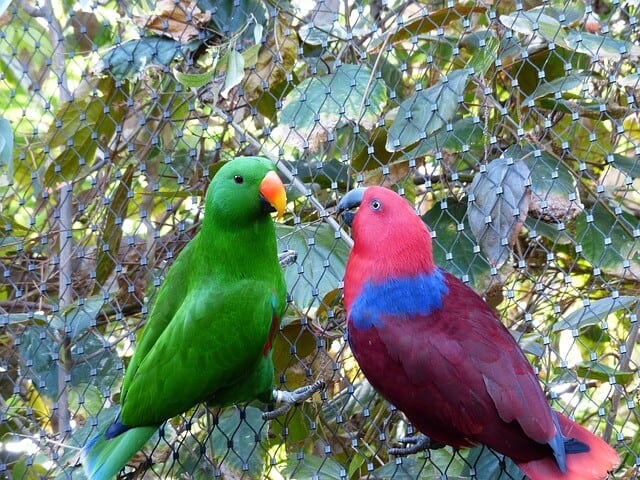
The Eclectus parrot is native to New Guinea, the Solomon Islands, Sumba, and northern Australia.
Eclectus parrots are unlike any other parrot species due to the striking sexual dimorphism in their plumage (Something referred to as Sexual Dimorphism).
Males are easily identified by their bright green (Emerald) feathers, while females are recognized by their bright red and purple or blue plumage.
They are so visually distinct from one another that someone unfamiliar with birds could easily mistake them for belonging to separate families.
The Eclectus parrot is a large, colorful bird that comes in nine different subspecies, including the Australian Eclectus parrot, the grand Eclectus, the Eclectus parrot of Sumba Island, the Eclectus parrot of Vosmaer’s Island, the Eclectus parrot of Solomon Island, the Eclectus parrot of the Tanimbar Islands, the Eclectus parrot of New Guinea, and others.
A wild Eclectus parrot can fetch anywhere from $1,000 to $3,000, depending on factors including its rarity and coloration.
9. Amazon Parrots
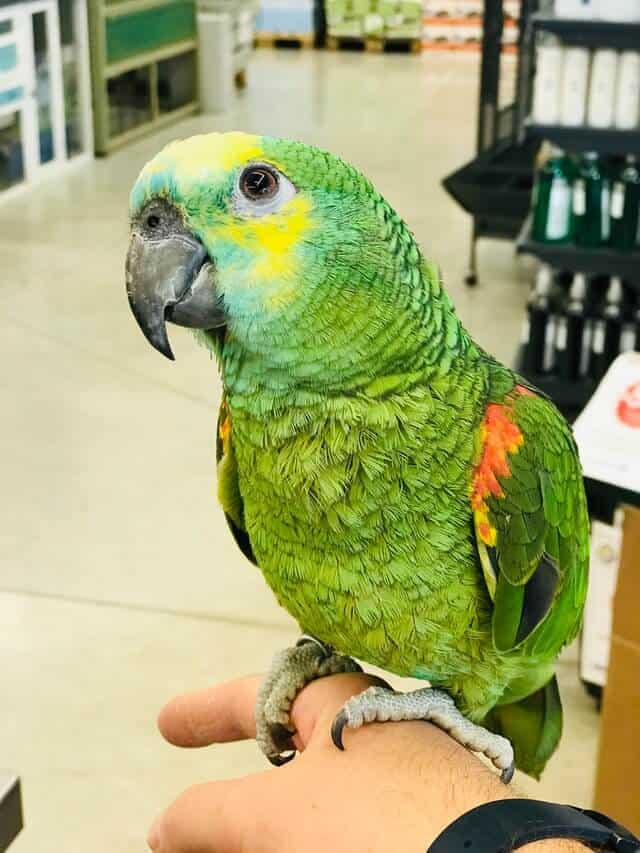
The Amazon parrot is a widespread species of medium-sized parrot native to the Americas and its subsequent spread to Mexico and the Caribbean.
Each species is easily identified by its unique combination of bright accent colors and short tail. A 30-50 year lifespan is possible for them.
Due to their striking resemblance to humans, Amazons quickly became popular as pet birds, leading to the rise of a lucrative business devoted to taming and selling Amazons from wild populations.
About 30 different Amazon parrot subspecies have been identified, including the Cuban Amazon, the Red-Lored Amazon, the Festive Amazon, the Orange-winged Amazon, the Yellow-Napped Amazon, and the Turquoise-Fronted Amazon, the Yellow-Crowned Amazon, the Lilacine Amazon, the Mealy Amazon, and many more.
Amazons can acquire hormone-related aggression and attack their owners.
However, there are two species that are considered to be exceptions because of their laid-back nature and kind personalities: The Red-Lored Amazon of Ecuador and the Mealy Amazon (Lilacine Amazon).
An Amazon parrot will set you back about $1500 on average. The most common sub-species will run you around $1,000, but the rarest can cost up to $3,000.
10. Budgerigars Parrots
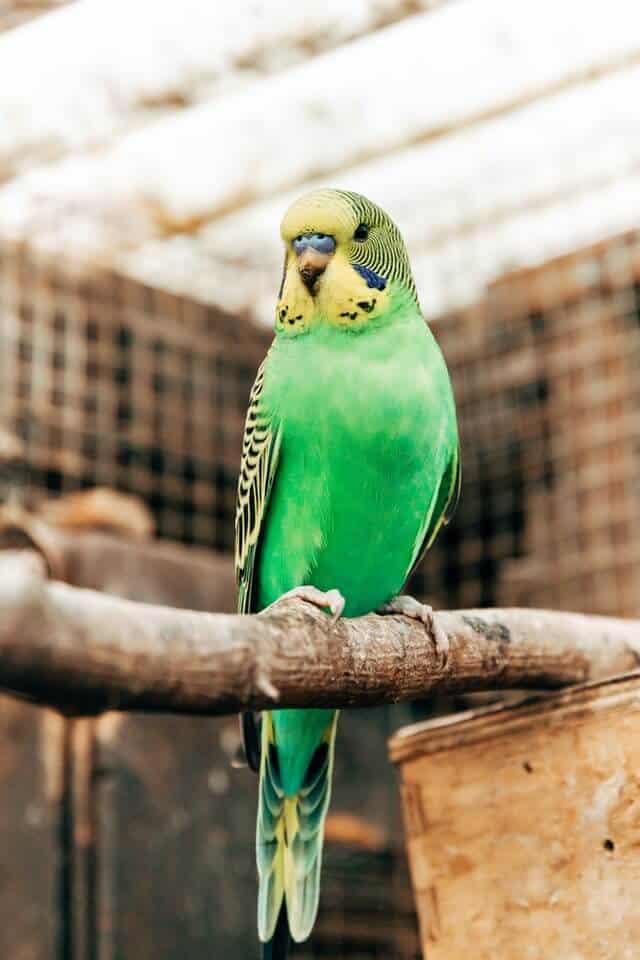
Parrots of the genus Budgerigar are commonly known as Budgies due to their diminutive stature and long tails.
However, in the United States, the term ‘Parakeet’ is used to describe just the Budgie species.
Wild Budgies often have a green body and a yellow head and a black back and neck.
Even so, captive breeding resulted in the development of a wide variety of mutants with hues other than black, including white, yellow, blue, and grey.
To put it simply, budgies are birds who consume seeds. The beaks of male and female Budgies are different.
Male birds are identified by their blue cere, while females are identified by their peeling brown cere (these are the natural colors).
Budgerigar parrots are inexpensive to keep because of their small size.
Veterinarians still advise feeding a diversified diet including seeds, fruits, pellets, and veggies.
Depending on the shop, the cost of a Budgie can be anywhere from $10 to $35. (Pet store VS. Breeder).
11. Australian King Parrot
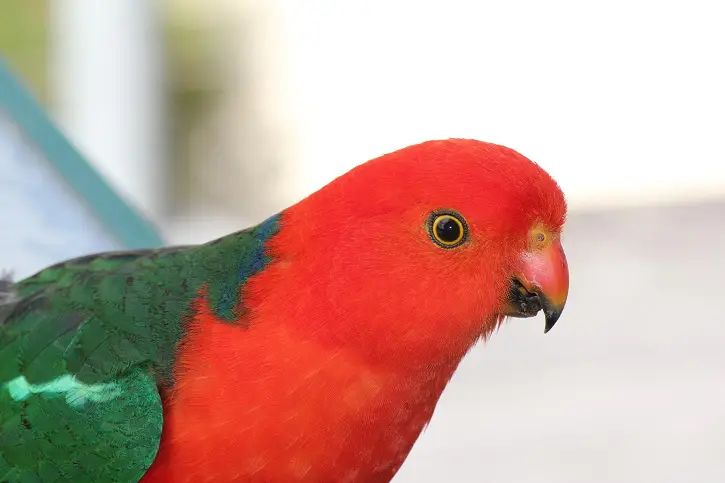
Training and teaching an Australian King Parrot to talk will need a significant commitment of time and energy, but the bird is capable of picking up the skill with effort.
The range of prices is from $100 to $500.
12. Blossom-Headed Parakeet
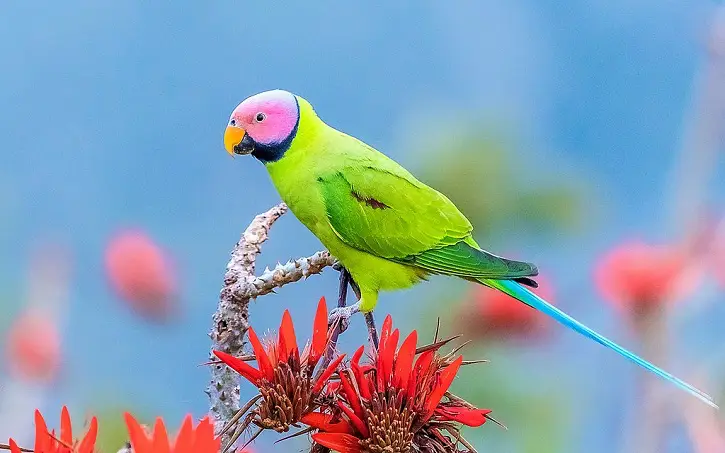
The Blossom-Headed Parakeet is an exceptionally unusual bird, and as a result, it is not commonly kept as a pet.
Despite this, the Blossom-Headed Parakeet is very capable of communicating verbally.
Because of how uncommon they are, the price for one of these birds can range anywhere from $600 to $900.
13. African Ringneck Parakeet
Training the African Ringneck Parakeet to talk will need to begin at a young age, but if you are patient with them, they will eventually pick up on the skill.
They often cost close to $200 for one.
14. Derbyan Parakeet
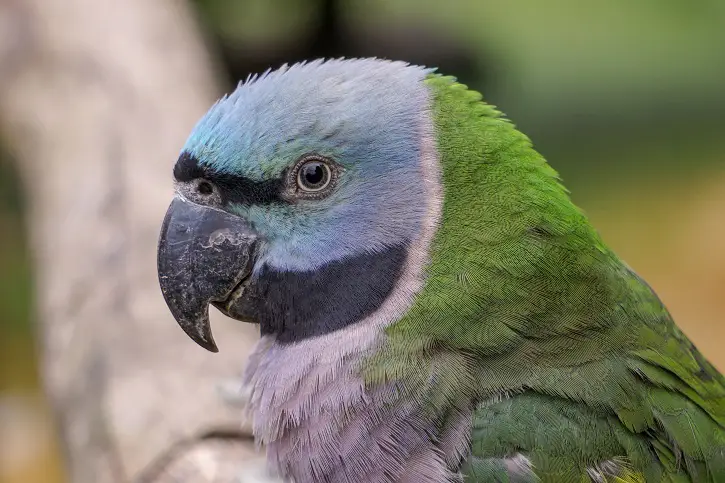
The Derbyan Parakeet is well-known for its exceptional communication abilities, which are frequently likened to those of amazon parrots; yet, its vocabularies are quite small.
They typically go for a high price, at around $1,500, when they are put up for sale.
15. Parrotlet
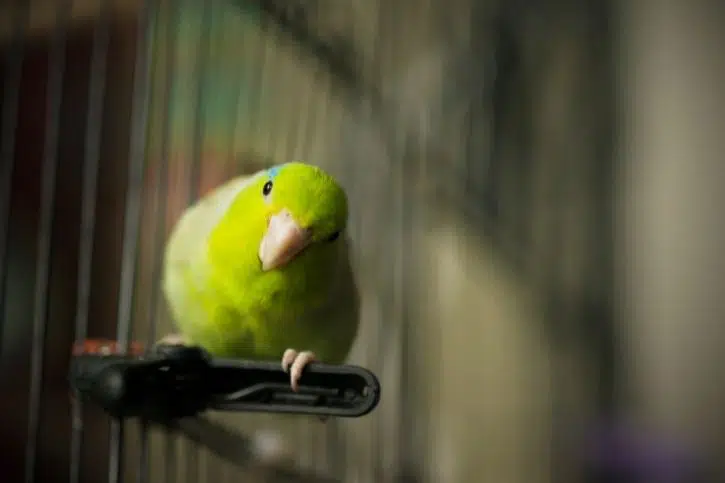
The term “parrotlet” refers to the tiniest of all parrots that are bred in captivity, and its literal translation is “little parrot.”
Adult parrotlets typically have a length of fewer than five inches (measured from the crest to the end of the tail) and weigh little more than 30 grams.
Although it is common knowledge that male parrots, including Parrotlet males, are better able to communicate verbally than their female counterparts, this does not indicate that females are incapable of picking up new skills.
It is possible that, given enough time, patience, and effort on your part, you will hear your bird repeating a few words or phrases.
The price of parrotlet can range anywhere from $150 to $400, depending on the color of its plumage.
Depending on the demand as well as the scarcity of the color, they might cost as much as $600.
Other Parrot Costs To Consider: Health, Food, And Housing
We have found that there is an up-front cost associated with adopting any species of parrot.
There will only be one payment of that amount required, and it will be for the purchase of the bird as a pet.
Aside from the initial investment, there are also recurring expenses to think about.
There are yearly fees, various monthly feeding expenses, vet bills following regular checkups, etc.
Adopting a single Congo African Grey parrot, for instance, will set you back between $1,500 and $3,500 over the course of a year.
While the sum total of these fees may not break the bank, it’s still best to get a firm grasp on the full picture before committing to the purchase of a parrot.
The overall cost will increase if you choose to have a larger parrot as opposed to a smaller one.
One-time expenses:
This is a one-time expenditure that will yield lasting benefits. A few examples are as follows:
- how much it will set you back to adopt a bird — we’ve already covered the usual adoption fees for all of the different species. (from as little as $10 to many thousand dollars for really rare species).
- The price of a bird cage – Ensure that the bird cage you purchase is large enough to accommodate your pet. Cages of varying quality can be found easily on the internet. Spend some more money on a good cage. If not, you’ll need to make the same financial commitment all over again. Cages can cost anywhere from $50 to $1500.
- Toys that provide mental and physical stimulation are crucial for your parrot’s happiness and well-being. They could run you anywhere from $25 to $150.
- Perches, platform stands, nests, grooming tools (for the nails, wings, etc.), birdbaths, transport carriers, cleaning materials, and anything else the bird and cage owner may possibly need. The selection of parrot cage accessories on sites like Amazon may surprise you. It’s imperative that you provide your buddy with high-quality goods that will last for years. You might spend anywhere from $ 220 to $600 on the aforementioned products.
What Factors Affect The Cost Of A Parrot?
In this final segment, we’ll examine the variables that go into determining a parrot’s selling price.
The price of a parrot can vary widely, from as little as $10 to as much as several thousand.
The moment has come to provide a more in-depth illustration of each component.
Species
This is the primary determinant of how much every given parrot costs.
More money will need to be spent on an alien species if it is scarce.
This is because collectors who pay a premium for such items tend to hold on to them.
Cockatiels, budgies, lovebirds, macaws, conures, African greys, parakeets, Amazon parrots, and other common domestic types are less expensive since they are bred professionally.
Size
The bird’s size is also an important consideration. In most cases, larger parrots will cost more than their smaller counterparts.
It’s not uncommon for large birds to live to be 70 or older, and all those extra years come with their own set of costs (other than the initial cost).
Keeping this in mind is important prior to purchasing a parrot as a pet.
Lifespan
Earlier, we established that larger birds, such as macaws, had a considerably longer lifespan than smaller parrots, like parakeets.
The purchase price and space requirements for housing larger birds are both higher.
In addition, it seems to reason that their appetites would be much larger than those of smaller birds.
The total expense of caring for a large parrot over the course of its lifetime can easily reach five figures.
Breeding location
The parrot’s price is also affected by whether it was wild-caught or bred in captivity.
Raised in captivity, parrots are more receptive to training than their wild counterparts.
They’re just more prepared to start speaking lessons.
A parrot that is regularly hand-fed by its owner is more likely to develop a strong attachment to that person.
Thus, parrots will become more devoted companions if they are fed by hand.
Purchase location
An earlier section of this article suggested that getting a parrot from a pet store would be far more cost-effective than getting one from a breeder.
It’s because bird breeders are experts in taking care of birds. Each bird’s details are recorded and kept track of.
Many aviary businesses also provide transport and housing for the birds they sell.
A parrot breeder will charge you significantly more, but they will provide superior service.
If your bird has or has had serious health difficulties, you’ll be able to see from its medical history whether or not it needs any additional care.
Age
A parrot’s price increases as it ages. Baby parrots are typically more affordable than adult parrots.
There is some evidence that older adult parrots lose the ability to do specific feats as they age.
A geriatric parrot, for instance, may find it more difficult to pick up new vocabulary.
In addition, once they reach adulthood, certain species of parrots become much less energetic than they were as youngsters.
Because of these two factors, efficiency may suffer. Therefore, it is usually best to choose a younger parrot over an older one.
Conclusion
Amazing things can be found in the world of parrots. Beautiful and entertaining, they can brighten up any dwelling.
Having a parrot as a pet means having a vibrant, lifelong friend at your side. Depending on the species, well-cared-for parrots can outlive their owners.
Since there are so many varieties of parrots, each with its own unique coloration, size, diet, and personality quirks, picking one to adopt can be a daunting endeavor.
There are those who are much simpler to instruct than others. The price of a parrot can vary greatly depending on its size and species.
We’ve done our best to include as much information as possible on parrot expenses and the requirements below.
We listed the top ten species of talking parrots kept as pets in the house.
We also included the typical price for each species in addition to describing their unique characteristics.
After that, we made a commitment to pay for any and all future and present costs associated with adopting a parrot.
More than that, we discussed what determines the cost of various parrot species and the factors that influence those costs.
The intent was to make it simpler and more transparent for any potential pet parent to acquire a parrot as a pet.
It’s time to break out the calculator and figure out how much money you’ll need to spend over the course of the animal’s lifetime to acquire your preferred species.
Afterward, you won’t have to worry about money.
